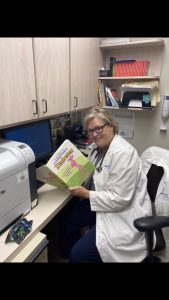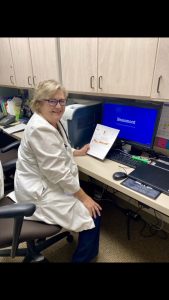18 USA, Donna Marvicsin
United States of America
The United States of America is located in North America, bordered by Pacific and Atlantic Ocean. Medicare and Medicaid are the healthcare programs of the USA. Medicare provides coverage for those who are 65 and older, with some coverage for those 65 and younger with certain disabilities or conditions. Medicaid provides coverage for those who are below a certain income level.
 I am Donna Marvicsin Phd, Pediatric Nurse Practitioner (PNP) and Certified Diabetes Educator (CDE). I am a Clinical Associate Professor at the University of Michigan School of Nursing which is located in Ann Arbor, Michigan in the USA. In this role I am the co-program lead of the Primary Care PNP program and teach graduate nursing students. In addition, two days a week I care for children with type 1 diabetes.
I am Donna Marvicsin Phd, Pediatric Nurse Practitioner (PNP) and Certified Diabetes Educator (CDE). I am a Clinical Associate Professor at the University of Michigan School of Nursing which is located in Ann Arbor, Michigan in the USA. In this role I am the co-program lead of the Primary Care PNP program and teach graduate nursing students. In addition, two days a week I care for children with type 1 diabetes.
The Covid-19 pandemic profoundly impacted my role both as an educator and as a nursing professional. All teaching and patient care became virtual within one week. The hospital system that I am affiliated with cancelled all outpatient clinics for one week and we had Informational Technology (IT) computer support and trainings on how to conduct telehealth virtual visits. This change in how I provided care had an unanticipated positive impact on my family nursing practice. The families were able to upload data from insulin pumps and continuous glucose monitors (CGM) to the cloud and then I was able to download and look at real time blood glucose and insulin delivery data. However, beyond the data and technology, it was even more striking to me how telehealth impacted patient and family empowerment as partners in their health care.
Think about it. A traditional visit has the patient entering the providers space, the exam room. They are visitors in my domain. I enter the room with a white lab coat and I ask the questions, I run the visit. The family is seen as my guest. All of a sudden, in one week, I am entering their homes. They invite me in through the telehealth visit portal. The parents and child or adolescent are sitting comfortably in their own homes. Perhaps at their kitchen table or sitting on their family room sofa. I am meeting the siblings and the pets. I am a guest, invited into their homes, getting introduced to the whole family. They feel safe and secure. I still am wearing the white lab coat and I ask all the traditional questions : have you been healthy since I last saw you? Do you have any aches or pains that I should know about? Do you have any questions or concerns about your blood sugars? The structure of the visit is the same, it is predictable, it is reassuring. However, I notice right away a difference in the dynamics of the communication. The family seems more relaxed, their responses flow like a conversation with a friend or neighbor.
At first, I think that the natural responses are because the families know me, I have been providing care for them since 2014. But then I realize I am also meeting many families for the first time. I worry that this will be difficult for them, I am a stranger to them. I am careful with my introduction; I reassure them that I have been taking care of children with diabetes since 1995. I have been trained to look at the camera on my device, so that the family feels I am making eye contact with them. I do not look at the screen. But to my amazement, the families are not uncomfortable at all! They seem to appreciate my concern, but then just jump right into sharing all the fears and anxieties they are living with.
In some ways, managing diabetes became easier for them. No eating out, no guessing at how may carbs are in the pizza. They have the label on the frozen pizza box. In other ways diabetes management became more challenging. I tease the adolescents that they are turning into vampires. I can see from the CGM data that they are snacking after their parents go to bed, that they fall asleep and stop eating in the early morning hours, I can see they are waking up well after noon and when they start eating again. But these are not the parents’ biggest concerns.
The families are afraid of this virus. Their child has an autoimmune condition. What does this mean? Is their child more at risk? Should they leave the house at all? The visits were not about blood glucose levels, I am reassuring the families, your child has a strong immune system, just a little confused. Your child will be able to fight off the virus like any other child. Remember to check for urine ketones for any signs or symptoms of illness. Remember to call us for moderate to large ketones, 24 hours a day, seven days per week. You are not alone; we are a team. We will help you navigate through this pandemic together, with this technology, even though my face is a tiny small picture on your mobile device. You are not alone, we are here, together, traveling through the scary times.
Through the magic of technology, the Covid 19 pandemic had an amazing impact on the care I provide families. Telehealth offers an intimate and empowering way to work with families. Families are now offered a choice for their visits and most are choosing to come back into the office for an in person visit. I think they appreciate the human connections, the return to “normal”. But hopefully the change in their feelings of empowerment, their trust and connections to us as providers, will continue.

Additional Information About Nursing in the United States of America
There are around 4 million nurses in the USA. Around 60% of them work in the private for profit sector, 30% in the private not for profit sector, and 10% in the public sector. For education, nurses in the USA must complete a bachelor’s degree in nursing, called a BSN (Bachelor’s of Science in Nursing). To practice in the USA, nurses must pass their NCLEX. Nursing in the USA is broad with many different groups. Among them are certified nursing assistant, licensed practical nurse and registered nurse. To further advance their careers, nurses can obtain more education to become a nurse practitioner, nurse anesthetist, or obtain a masters or doctorate in nursing.
Media Attributions
- Donna Marvicsin 1-1
- Donna Marvicsin
